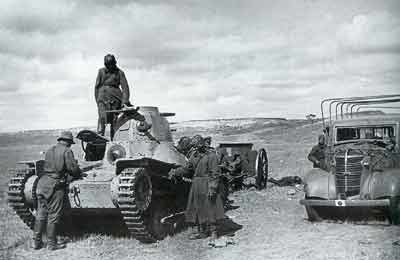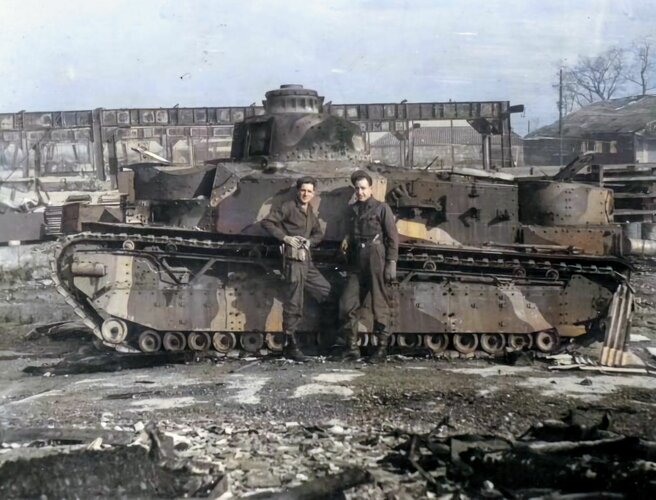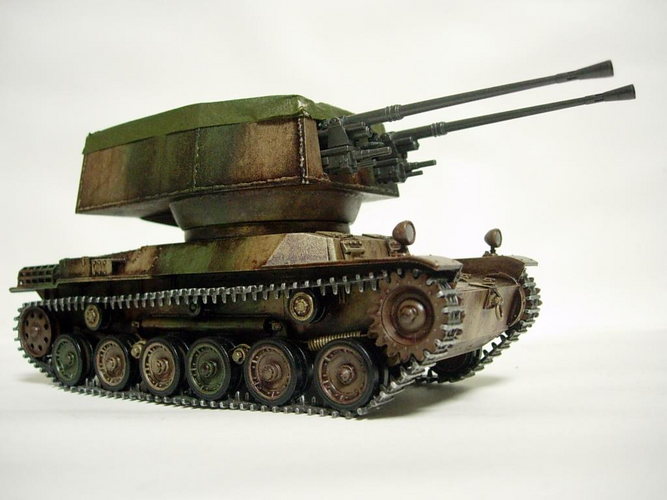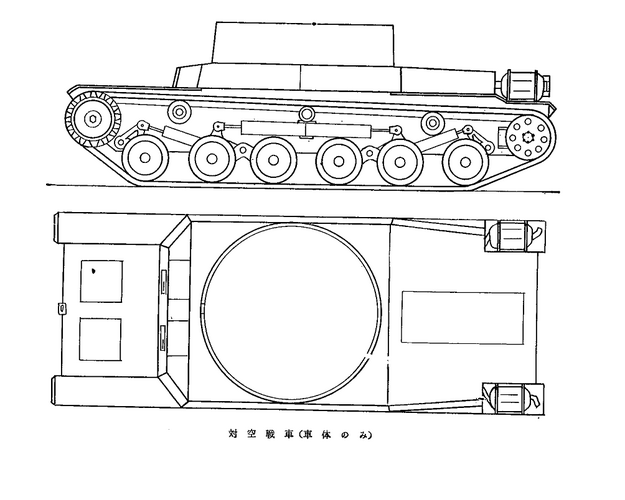Hello,for almost a year i was looking for japanese tanks/projects.I think everybody know about tanks like Chi-Ha or Chi-Nu.Unfortunately, not all tanks are as easy to find as Chi-Ha.In future I want to present a book called "Japanese tanks and projects".So today i want to show information that i found.
I-Go/Chi-Ro:
After a request from the IJN for a medium tank, Osaka Army Arsenal (Osaka Rikugun Zoheisho) purchased a British Vickers Medium C, then a British medium design in the early stages of conception. The same arsenal had already produced, in 1925, a light tank prototype, which was rejected by the General Staff Office, because of its low speed and very thin armor. In addition, its weight had already risen to nearly 12 tons, too much for a light type. The design was redrawn in 1928, using the Vickers Medium C as a basis, as the army requested a nominal 10 short ton (9.1 metric ton) weight.
The Type 87, 9.8 ton medium tank was born. However, once tested, it was also rejected. A second design, ready in April 1929, was finally accepted as the Type 89 I-Go (or Yi-Go). The production model’s weight rose to 12.8 metric tons. A contract was awarded to Mitsubishi Heavy Industries, which furnished a new purpose-built factory near Sagami Arsenal.

Early version called I-Go Ko

Chi-Ro late version.Difference between Ko is another turret.
Ha-Go:



Ha-Go with the 37mm gun replaced with the Chi-Ha's 57mm gun. This modification was known as the Type 3 Ke-Ri.
The Ha-Go can trace its roots as far back as 1933. Then, the Type 89, only able to achieve infantry pace, was duly put on a replacement schedule. The I-Go was (relatively) heavy, well armored, with a moderately efficient low-velocity 57 mm (2.24 in) gun, but utterly slow. The general Army Staff put forth a demand for a lightweight fast tank, which would not only be used for infantry support, but also to spearhead motorized attacks, at truck speed. The Army Technical Bureau studied models from abroad, as a Japanese delegation attended trials of Christie tanks and Carden-Lloyd tankettes, as well as French cavalry models.However, the model designed in 1934 used a custom, simple suspension, with distinctive large bell cranks, which represented a large part of the hull length. The cavalry demanded a fast machine, the infantry a better protected one, but the former won in the end. The plans were ready in 1935, and Mitsubishi Heavy Industries was quickly ordered to produce a first batch of machines, but only 100 were built by 1939. After that, orders were also placed to Sagami Arsenal, Hitachi Industries, Niigata Tekkosho, Kobe Seikosho, and Kokura Arsenal. Together, they produced 1250 more machines until 1942. Mitsubishi also went on to produce 850 more vehicles.
Chi-Ha & Chi-Ha Kai

Early production model

Chi-Ha Kai.Main difference is another turret and gun.

12cm Short Gun

12cm Long Gun
The Type 97 Chi-Ha, with nearly 2100 units built (including the improved (Kai) version), was the second most produced tank in Japanese history, after the smaller Ha-Go. It was found everywhere in Asia, soldiering from the cold steppes of northern Manchuria and Mongolia to the jungles of New Guinea, Burma, the Eastern Indies, and all around the Pacific.
The Chi-Ha (“medium tank third”), or ordnance Type 97, referring to the imperial year 2597, was first preceded by a thorough examination of the main IJA medium tank by 1935, the I-Go. It had proven to be too slow to operate effectively on the wide expenses of China, and did not suit well with the new tactical requirements of motorized warfare, as seen particularly during the invasion of Manchuria.
As a result, a new specification was issued to Japanese companies, among those Mitsubishi, which responded quickly with a design of its own, inspired by the fast light tank Ha-Go. The Tokyo Mitsubishi Heavy Industries complex delivered and tested the first prototype as early as April 1937, followed by a second one in June. As required by the ordnance, it had the same 57 mm (2.24 in) gun featured on the Type 89. Meanwhile, Osaka Arsenal also delivered its prototype. Although cheaper than the former, it was ultimately rejected because of the end of all peacetime budgetary limitations, following the second Sino-Japanese war of June 1937.
Chi-He

The Type 1 Chi-He was an attempt by Mitsubishi to modernize the Chi-Ha, the latter being later upgraded to the Kai standard in 1942. The efforts of the engineers were aimed at increasing the protection level and improve the main gun range, speed and accuracy. The American M4 Shermanwas especially in their minds. Unfortunately, production was delayed due to steel shortages, reserved prioritarily for warship construction. When the production run ended in early 1944, after 170 units built*, the model was desperately outdated.
Chi-Nu/Chi-Nu II & Chi-Nu Kai


Chi-Nu Kai(up) and Chi-Nu II(down)
Called the Chi-nu, this new model was devised as early as 1943, when it became apparent that even the high-velocity 47 mm (1.85 in) gun on the Chi-Ha Kai would not be enough against the Sherman's frontal armor. The initial Army Technical Bureau program, the future Chi-To, was not ready on schedule, accumulating problems and production delays. So much so that the army decided to produce a stopgap tank, based on the existing and improved Type 1 Chassis
Chi-To

Chi-To Prototype

Blueprints of production version
Among the various medium tank designs developed in 1944, the Chi-To was probably the most promising. The development started while the Chi-Ha Kai was still in production in 1943. The specifications were simple, requiring 75 mm (2.95 in) of armor and a high velocity 75 mm (2.95 in) gun. It was indented to be used against the most current Allied tank of the time, the M4 Sherman.
Chi-Ri/Chi-Ri II

First version,It was similar to Chi-To but had lenghted chassis

Chi-Ri II Prototype found by americans
The Type 5 Chi-Ri was based on a lengthened version of the Type 4 Chi-To chassis (8 road wheels), with thicker sloped welded armor. This included 75 mm (2.95 in) on the frontal glacis, and from 25 to 50 mm (0.98-1.97 in) on the sides, rear and turret. Initially, it was to be powered by a Mitsubishi diesel engine, but a 800 hp V-12 gasoline-fueled aircraft engine designed by BMW, licence built by Kawasaki Heavy Industries, was selected instead. There were four bogies of two roadwheels each, on Bell crank suspensions.
If you got some suggestions,write me patinghjohn@gmail.com
I-Go/Chi-Ro:
After a request from the IJN for a medium tank, Osaka Army Arsenal (Osaka Rikugun Zoheisho) purchased a British Vickers Medium C, then a British medium design in the early stages of conception. The same arsenal had already produced, in 1925, a light tank prototype, which was rejected by the General Staff Office, because of its low speed and very thin armor. In addition, its weight had already risen to nearly 12 tons, too much for a light type. The design was redrawn in 1928, using the Vickers Medium C as a basis, as the army requested a nominal 10 short ton (9.1 metric ton) weight.
The Type 87, 9.8 ton medium tank was born. However, once tested, it was also rejected. A second design, ready in April 1929, was finally accepted as the Type 89 I-Go (or Yi-Go). The production model’s weight rose to 12.8 metric tons. A contract was awarded to Mitsubishi Heavy Industries, which furnished a new purpose-built factory near Sagami Arsenal.
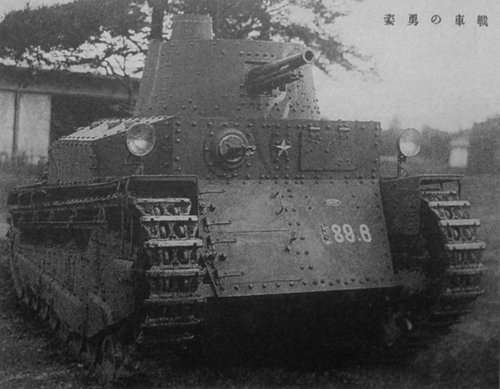
Early version called I-Go Ko
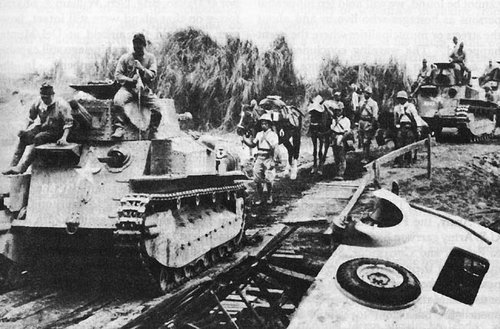
Chi-Ro late version.Difference between Ko is another turret.
Ha-Go:
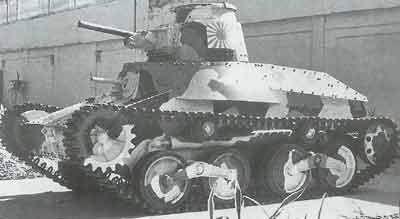
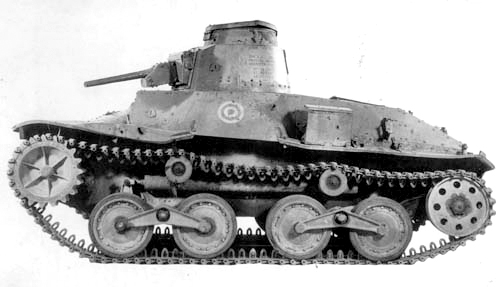
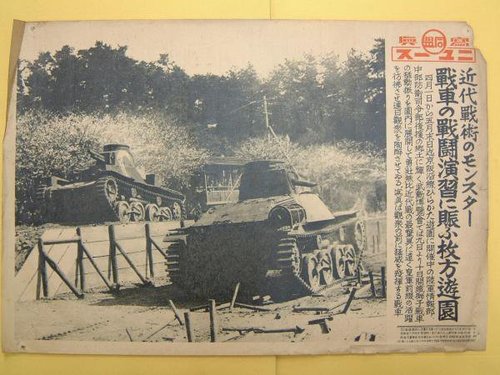
Ha-Go with the 37mm gun replaced with the Chi-Ha's 57mm gun. This modification was known as the Type 3 Ke-Ri.
The Ha-Go can trace its roots as far back as 1933. Then, the Type 89, only able to achieve infantry pace, was duly put on a replacement schedule. The I-Go was (relatively) heavy, well armored, with a moderately efficient low-velocity 57 mm (2.24 in) gun, but utterly slow. The general Army Staff put forth a demand for a lightweight fast tank, which would not only be used for infantry support, but also to spearhead motorized attacks, at truck speed. The Army Technical Bureau studied models from abroad, as a Japanese delegation attended trials of Christie tanks and Carden-Lloyd tankettes, as well as French cavalry models.However, the model designed in 1934 used a custom, simple suspension, with distinctive large bell cranks, which represented a large part of the hull length. The cavalry demanded a fast machine, the infantry a better protected one, but the former won in the end. The plans were ready in 1935, and Mitsubishi Heavy Industries was quickly ordered to produce a first batch of machines, but only 100 were built by 1939. After that, orders were also placed to Sagami Arsenal, Hitachi Industries, Niigata Tekkosho, Kobe Seikosho, and Kokura Arsenal. Together, they produced 1250 more machines until 1942. Mitsubishi also went on to produce 850 more vehicles.
Chi-Ha & Chi-Ha Kai
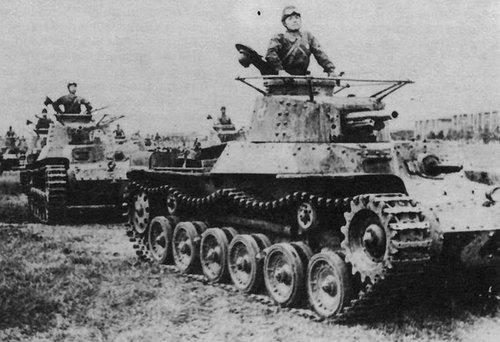
Early production model
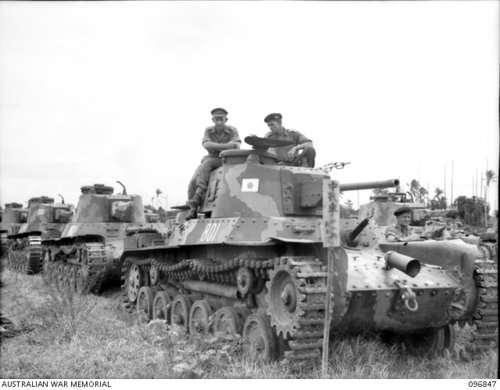
Chi-Ha Kai.Main difference is another turret and gun.
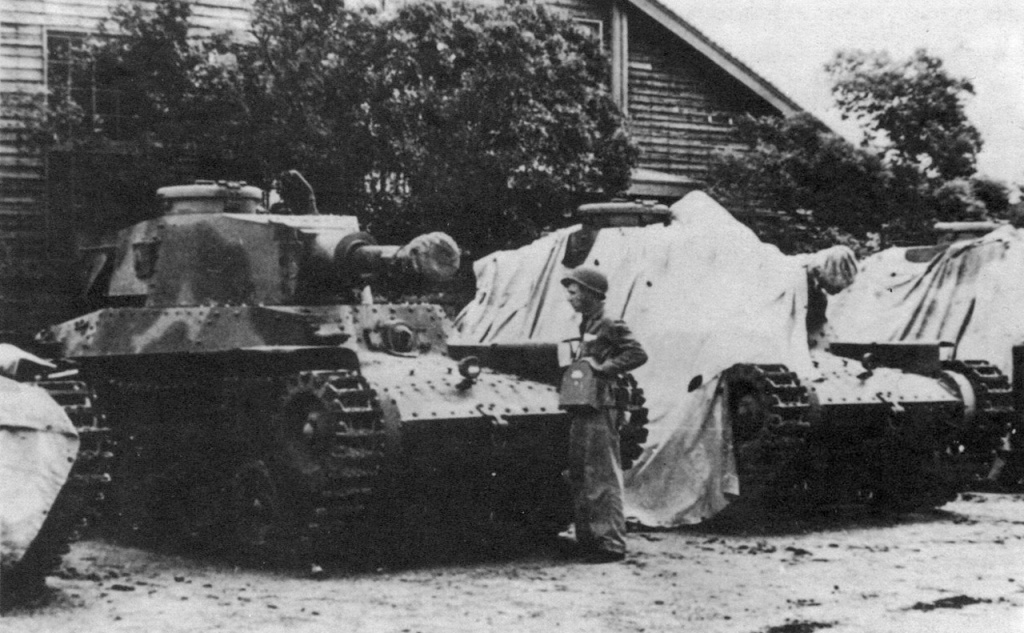
12cm Short Gun

12cm Long Gun
The Type 97 Chi-Ha, with nearly 2100 units built (including the improved (Kai) version), was the second most produced tank in Japanese history, after the smaller Ha-Go. It was found everywhere in Asia, soldiering from the cold steppes of northern Manchuria and Mongolia to the jungles of New Guinea, Burma, the Eastern Indies, and all around the Pacific.
The Chi-Ha (“medium tank third”), or ordnance Type 97, referring to the imperial year 2597, was first preceded by a thorough examination of the main IJA medium tank by 1935, the I-Go. It had proven to be too slow to operate effectively on the wide expenses of China, and did not suit well with the new tactical requirements of motorized warfare, as seen particularly during the invasion of Manchuria.
As a result, a new specification was issued to Japanese companies, among those Mitsubishi, which responded quickly with a design of its own, inspired by the fast light tank Ha-Go. The Tokyo Mitsubishi Heavy Industries complex delivered and tested the first prototype as early as April 1937, followed by a second one in June. As required by the ordnance, it had the same 57 mm (2.24 in) gun featured on the Type 89. Meanwhile, Osaka Arsenal also delivered its prototype. Although cheaper than the former, it was ultimately rejected because of the end of all peacetime budgetary limitations, following the second Sino-Japanese war of June 1937.
Chi-He
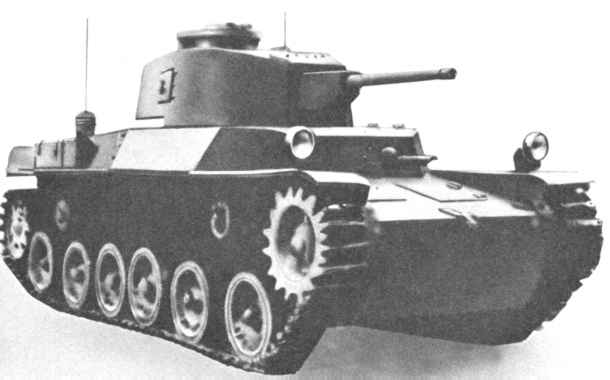
The Type 1 Chi-He was an attempt by Mitsubishi to modernize the Chi-Ha, the latter being later upgraded to the Kai standard in 1942. The efforts of the engineers were aimed at increasing the protection level and improve the main gun range, speed and accuracy. The American M4 Shermanwas especially in their minds. Unfortunately, production was delayed due to steel shortages, reserved prioritarily for warship construction. When the production run ended in early 1944, after 170 units built*, the model was desperately outdated.
Chi-Nu/Chi-Nu II & Chi-Nu Kai
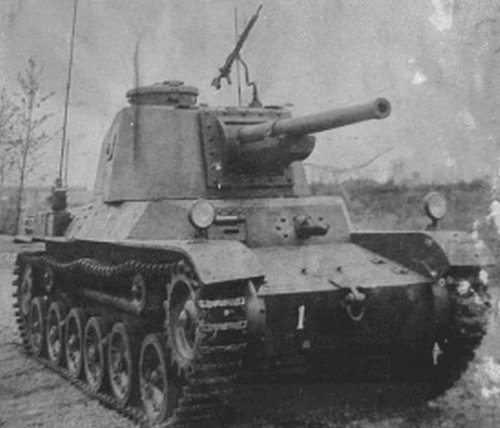
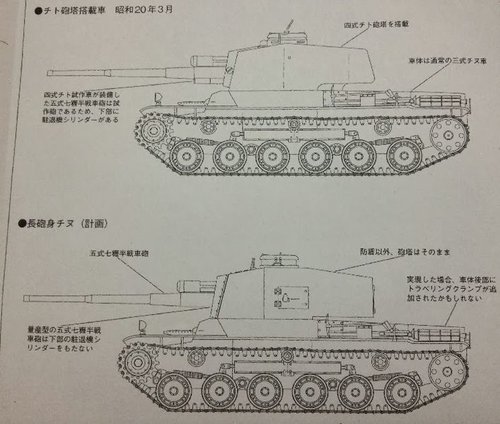
Chi-Nu Kai(up) and Chi-Nu II(down)
Called the Chi-nu, this new model was devised as early as 1943, when it became apparent that even the high-velocity 47 mm (1.85 in) gun on the Chi-Ha Kai would not be enough against the Sherman's frontal armor. The initial Army Technical Bureau program, the future Chi-To, was not ready on schedule, accumulating problems and production delays. So much so that the army decided to produce a stopgap tank, based on the existing and improved Type 1 Chassis
Chi-To
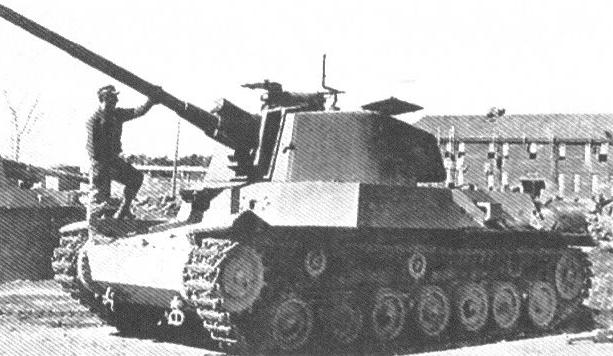
Chi-To Prototype
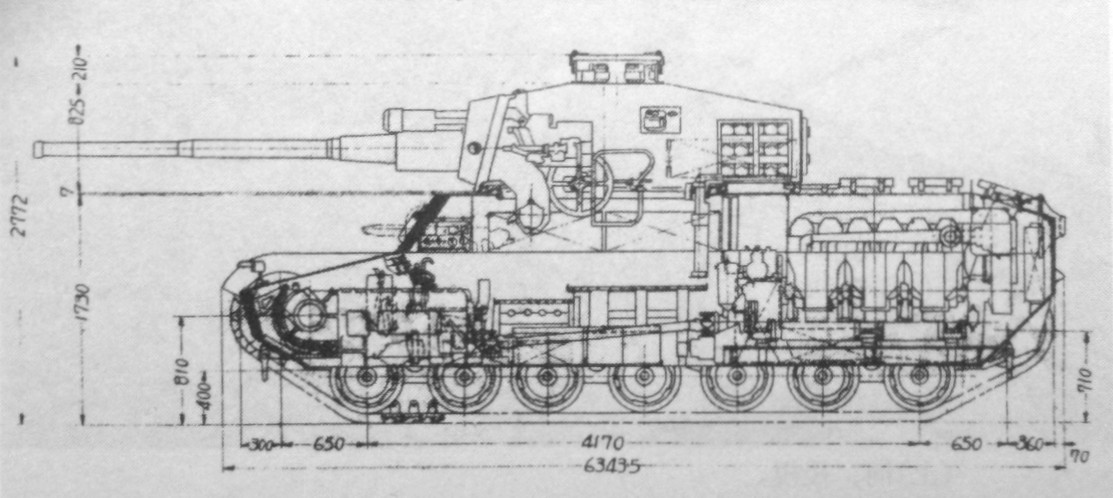
Blueprints of production version
Among the various medium tank designs developed in 1944, the Chi-To was probably the most promising. The development started while the Chi-Ha Kai was still in production in 1943. The specifications were simple, requiring 75 mm (2.95 in) of armor and a high velocity 75 mm (2.95 in) gun. It was indented to be used against the most current Allied tank of the time, the M4 Sherman.
Chi-Ri/Chi-Ri II
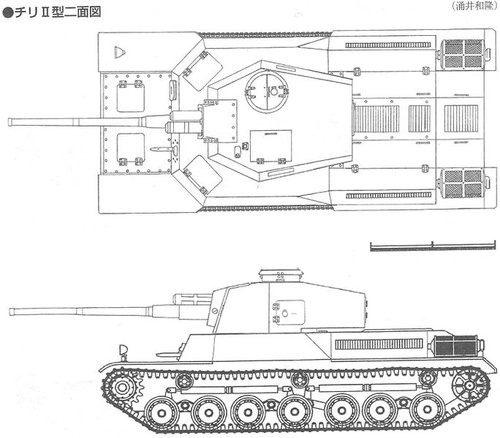
First version,It was similar to Chi-To but had lenghted chassis
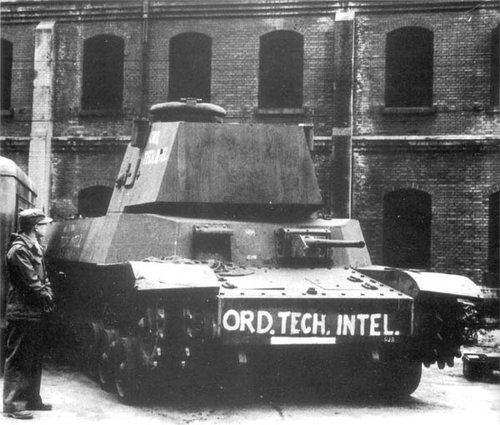
Chi-Ri II Prototype found by americans
The Type 5 Chi-Ri was based on a lengthened version of the Type 4 Chi-To chassis (8 road wheels), with thicker sloped welded armor. This included 75 mm (2.95 in) on the frontal glacis, and from 25 to 50 mm (0.98-1.97 in) on the sides, rear and turret. Initially, it was to be powered by a Mitsubishi diesel engine, but a 800 hp V-12 gasoline-fueled aircraft engine designed by BMW, licence built by Kawasaki Heavy Industries, was selected instead. There were four bogies of two roadwheels each, on Bell crank suspensions.
If you got some suggestions,write me patinghjohn@gmail.com

